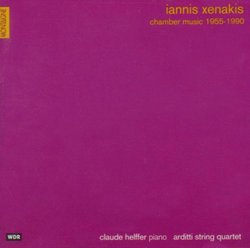| All Artists: Iannis Xenakis, Claude Helffer Title: Iannis Xenakis: Chamber Music, 1955 - 90 Members Wishing: 1 Total Copies: 0 Label: Disques Montaigne Release Date: 7/1/2003 Genre: Classical Styles: Chamber Music, Forms & Genres, Short Forms, Instruments, Keyboard, Strings Number of Discs: 2 SwapaCD Credits: 2 UPCs: 3298497821377, 822186821374 |
Search - Iannis Xenakis, Claude Helffer :: Iannis Xenakis: Chamber Music, 1955 - 90
 | Iannis Xenakis, Claude Helffer Iannis Xenakis: Chamber Music, 1955 - 90 Genre: Classical
|
Larger Image |
CD Details |
CD ReviewsXenakis' vast ideas played by small forces Christopher Culver | 01/19/2009 (4 out of 5 stars) "A lot of people come to Iannis Xenakis' music through big orchestral pieces like "Metastasis" or "Jonchaies". The composer nonetheless wrote an enormous amount of music for piano, solo strings, and string quartets and quintets. This Naive disc, a 2000 reissue of an early 1990s Montaigne release, presents these small-scale pieces in performance by the Arditti Quartet (here Irvine Arditti, David Alberman, Garth Knox, and Rohan de Saram) and pianist Claude Helffer. "Evryali" for piano (1973) might be the best way into the collection. Its bouncy rhythms and fairly tame harmonies are immediately appealing. Its virtuoso demands increase steadily until the climax when left and right hands seem in completely different worlds entirely. It is "modernist" and "angular", but also joyful and engaging. Much the same can be said for the short "A r. (Hommage a Ravel)" for piano (1987), with its lovely ascending and descending runs punctuated by chords, and the long "Mists" for piano (1981) delights in music of separate thick strands, creating lovely clouds of sound. On the other hand, "Herma" for piano (1962) belong to Xenakis' early period of bleep-bloopy stochastic music. Then there are the solo string works, which are relatively straightfoward. In "Mikka" and "Mikka 'S'" for violin (1971-1976), the performer plays a musical line consisting only of glissandi. In "Embellie" for viola (1981) Xenakis celebrates the rich colours inherent in this instrument, making a very pleasurable contribution to the viola golden age we're living in (it accompanies well the solo viola works of Ligeti, Grisey and Murail). Most striking here will be the allusions to the classical tradition, with the performer at more than one point seeming to channel Bach's sonatas for solo violin. "Nomos Alpha" for cello (1965-66) is one of Xenakis' most hardcore mathematical pieces, generated by the roll of dice. It has every cello technique you can think of, and Rohan de Saram claims that years of grappling with "Nomos Alpha" made him an all-around better cellist. I have to say I prefer Siegfried Palm's performance on a DG reissue which is more rich and expressive. "Kottos" for cello (1977) is also formidable, but with a clear musical line. "Dikthas" for violin and piano (1979) revisits the concerns of some of the solo works already heard. The violin moves in frequent glissandi, while the piano part is as exhuberant as "Mists". The subtle microtonal inflections on the violin, which produce beating against the piano line, give the piece a great deal of replay value. And then we have the string quartets. "ST/4" (1962) belongs to a series of computer-generated works, but while the music goes everywhere with wild abandon both pizzicato and sul arco, frequent tremolo gestures seem to keep it rooted. "Ikhoor" (1978) is remarkably similar to Xenakis' orchestral "Jonchaies", opening with the same bouncy rhythms. This is a work of great passion and energy, and will probably appeal to a lot of listeners. The latter two quartets were written especially for the Ardittis. With its isolated creakings "Tetras" (1983) has an air of Lachenmann about it. "Tetora" (1990) is a typical example of the late Xenakis, blocky chords moving in fairly tame rhythms, with vague references to indigenous traditions (I personally hear a little bit of Andalucian music). Sadly the Ardittis never went on to tackle Xenakis' last quartet, "Ergma", written in 1994, which has concerns similar to "Tetora". Finally, there's the piano quintet "Akea" (1986), one of the strangest works here. Here the tropes of Romanticism seem to filter through Xenakis' heavy modernism. Some have found Xenakis' chamber works to be disappointing, and this I must dispute. While not all the pieces here are gold, I nonetheless find some of these to be among his best pieces. Few pieces show the beauty Xenakis' mathematical approach could produce like "Evryali", and the glissandi writing the composer so loved is still little heard in contemporary music." Simply Exceptional! Eric Falardeau | Montreal, Quebec Canada | 07/03/2008 (5 out of 5 stars) "This two-disks CD contains key chamber works, including all three string quartets. The Arditi quartet, paired with Claude Helffer, performs to perfection. Sound engineering is also very good."
|

 Track Listings (9) - Disc #1
Track Listings (9) - Disc #1